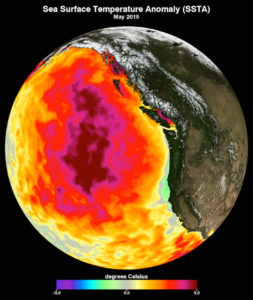
This data image shows the monthly average sea surface temperature for May 2015. Between 2013 and 2016, a large mass of unusually warm ocean water–nicknamed the blob–dominated the North Pacific, indicated here by red, pink, and yellow colors signifying temperatures as much as three degrees Celsius (five degrees Fahrenheit) higher than average. Data are from the NASA Multi-scale Ultra-high Resolution Sea Surface Temperature (MUR SST) Analysis product. (Courtesy NASA Physical Oceanography Distributed Active Archive Center)
Enabled by the JGI’s Community Science Program, a team led by University of British Columbia researchers tracked the impact of a large-scale heatwave event in the ocean known as “The Blob.” The microbial communities in the ocean drive the biological pump that takes carbon from the atmosphere and keeps it in the deep ocean. With genomic samples collected before, during and after The Blob, the researchers developed a preliminary model of how marine microbial communities are affected by warming events. They recently shared their findings in Communications Biology. The work underscores the value of large-scale research collaborations and of conducting even more time-series studies.
Learn more here on the JGI website.




